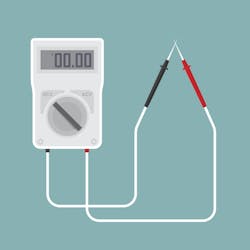Tip of the Week: Is that test really necessary?
Do you use test equipment that is appropriate for the test being conducted? Or do you try to make one instrument do all kinds of jobs? Do you perform tests that are not even necessary?
Consider the case of an electrician who perhaps had too much appreciation for his insulation resistance (IR) tester. Large portions of the equipment grounding conductor (EGC) in his plant consist of insulated conductors. So he conducted IR testing on these conductors.
Although that testing does allow predicting when that insulation will fail, it’s also true that the uninsulated raceway in this same plant is part of the EGC. That EGC insulation probably did not need to be tested.
Does this mean you don’t do any testing on the EGC? The purpose of the EGC is to provide a low-resistance ground-fault current path [see NEC Art. 100], thereby allowing protective devices to open when there’s a fault. It connects normally non-current carrying metal parts of equipment together and to the system grounded conductor or to the GEC, or both. So it’s pretty important.
Visual inspection is part of good preventive maintenance practices for the EGC. In many facilities, the connections are tested using a digital low resistance ohmmeter (DLRO). You wouldn’t use a DLRO to test your conductor insulation, and the IR tester isn’t the tool for testing EGC connections. You need both tools and the understanding of how to use them to achieve the desired goal.
And, of course, your handy and useful digital multimeter is the wrong tool to use for either job (unless it’s a combo unit with these specific functions included).
About the Author

Mark Lamendola
Mark is an expert in maintenance management, having racked up an impressive track record during his time working in the field. He also has extensive knowledge of, and practical expertise with, the National Electrical Code (NEC). Through his consulting business, he provides articles and training materials on electrical topics, specializing in making difficult subjects easy to understand and focusing on the practical aspects of electrical work.
Prior to starting his own business, Mark served as the Technical Editor on EC&M for six years, worked three years in nuclear maintenance, six years as a contract project engineer/project manager, three years as a systems engineer, and three years in plant maintenance management.
Mark earned an AAS degree from Rock Valley College, a BSEET from Columbia Pacific University, and an MBA from Lake Erie College. He’s also completed several related certifications over the years and even was formerly licensed as a Master Electrician. He is a Senior Member of the IEEE and past Chairman of the Kansas City Chapters of both the IEEE and the IEEE Computer Society. Mark also served as the program director for, a board member of, and webmaster of, the Midwest Chapter of the 7x24 Exchange. He has also held memberships with the following organizations: NETA, NFPA, International Association of Webmasters, and Institute of Certified Professional Managers.
